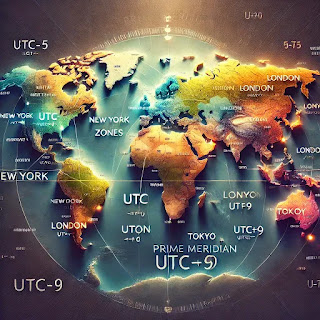Understanding Time Zones: A Global Perspective of Timekeeping
Independent Researcher
M.A, B.Ed.
Aliah University, Kolkata
Introduction
Have you ever wondered why the
world doesn’t operate on a single universal time? Why do some countries have
half-hour or even quarter-hour time differences? Time zones are crucial in coordinating global activities, from business and travel to international
communication. In this blog, we’ll dive into how time zones work, their
origins, and why they’re more complex than they appear.
The Origins of
Time Zones
Until the 19th century, each town
and city followed its own local time, based on the position of the sun. This
meant that time varied slightly from place to place. However, as railroads and
telegraphs expanded, a standardized system became necessary to avoid confusion.
In the 1870s, Canadian engineer Sir
Sandford Fleming proposed the modern system of time zones. Then, in 1884,
the International Meridian Conference in Washington, D.C., established Greenwich
Mean Time (GMT) as the standard reference point. This led to the world
being divided into 24 time zones, each covering about 15 degrees of longitude.
How Time Zones
Work
Time zones are based on the Earth’s
rotation. Since our planet rotates 360 degrees in 24 hours, it moves 15 degrees
every hour. Each time zone typically spans 15 degrees of longitude and is
offset from GMT (or its modern equivalent, Coordinated Universal Time – UTC)
by whole or fractional hours.
For example:
- UTC+0 – London (GMT)
- UTC+5:30 – India (Indian Standard Time)
- UTC-5 – New York (Eastern Standard Time)
- UTC+9 – Tokyo (Japan Standard Time)
However, real-world time zone
boundaries don’t always follow this ideal system. Many countries adjust their
time zones for political, economic, or practical reasons.
Daylight Saving
Time and Its Impact
Some regions use Daylight
Saving Time (DST), where clocks are set forward by one hour in summer to
extend daylight hours in the evening. First introduced during World War I to
conserve energy, DST is still in use today, though its effectiveness remains a
topic of debate.
For example:
- The United States observes DST, except for Hawaii and most
of Arizona.
- India and China do not use DST.
- The European Union has proposed abolishing DST, and the
discussion is ongoing.
Unconventional
Time Zones and Exceptions
While most time zones follow a
one-hour difference, some countries and regions use 30-minute or 45-minute
offsets:
- India (IST) – UTC+5:30
- Nepal (NPT) – UTC+5:45
- Newfoundland, Canada (NST) – UTC-3:30
- Iran (IRST) – UTC+3:30
China, despite spanning five
geographical time zones, follows a single national time zone (UTC+8).
This means that in some parts of China, the sun may not rise until 10 AM!
The Future of
Time Zones
As globalization and digital
communication continue to grow, some experts have suggested eliminating time
zones entirely in favor of a single universal time. However, cultural and
social habits make this unlikely. Instead, technology is making it easier to
adapt—world clocks, smartphone time conversions, and digital scheduling tools
help people manage time differences more efficiently.
Conclusion
Time zones are an interesting mix
of science, history, and politics. While they help synchronize global
activities, they also introduce quirks that can sometimes be confusing. Whether
you're traveling, scheduling meetings, or simply curious about the world,
understanding time zones can help make sense of our interconnected planet.
What are your thoughts on time
zones? Should we reduce their number, or is the current system just fine? Let’s
discuss this in the comments! 😊
Thanks for reading!


Post a Comment